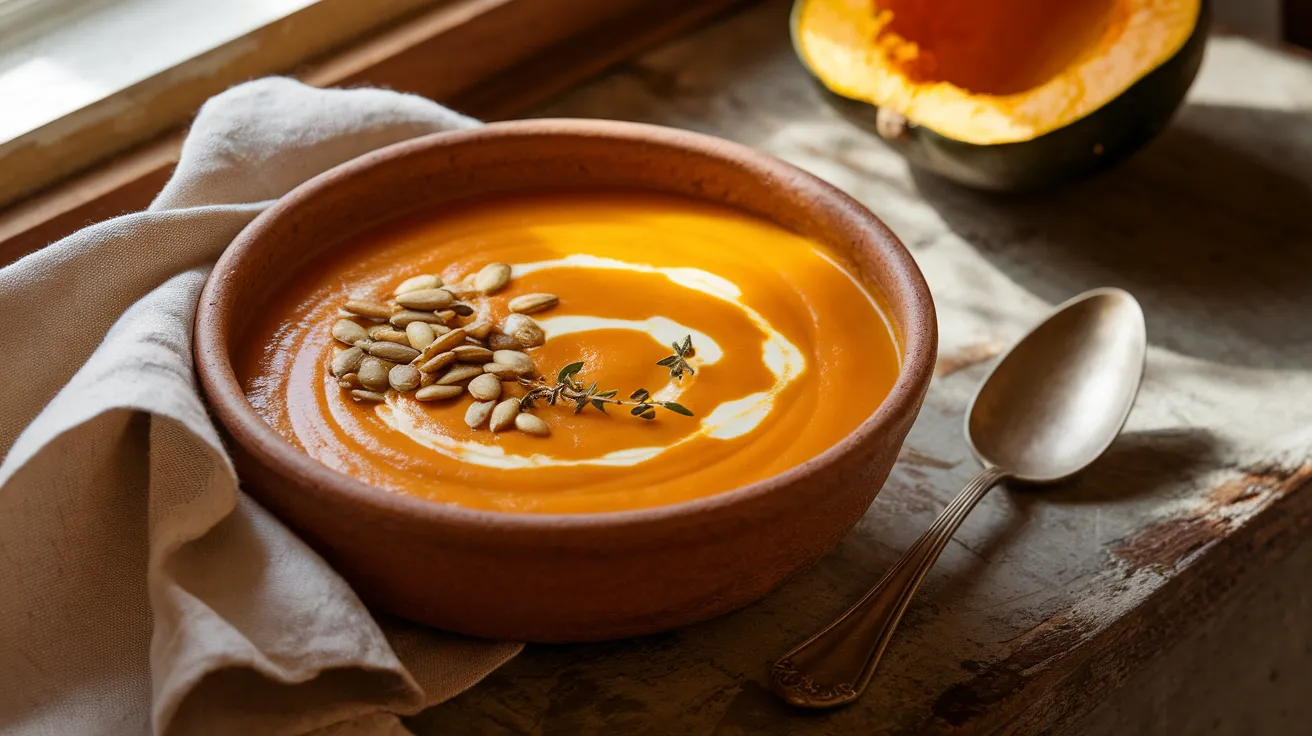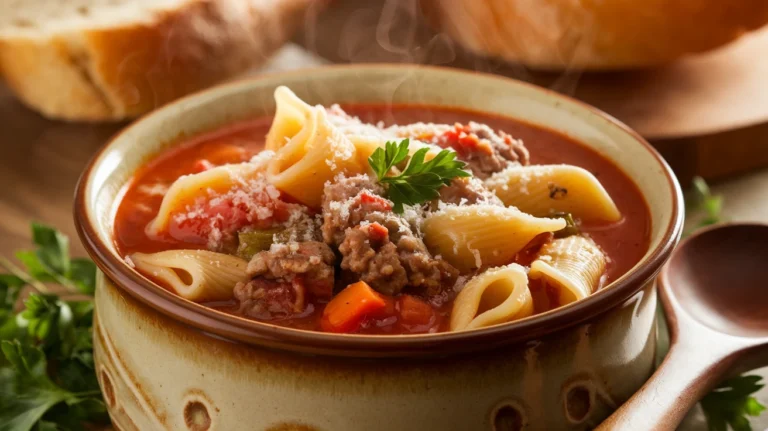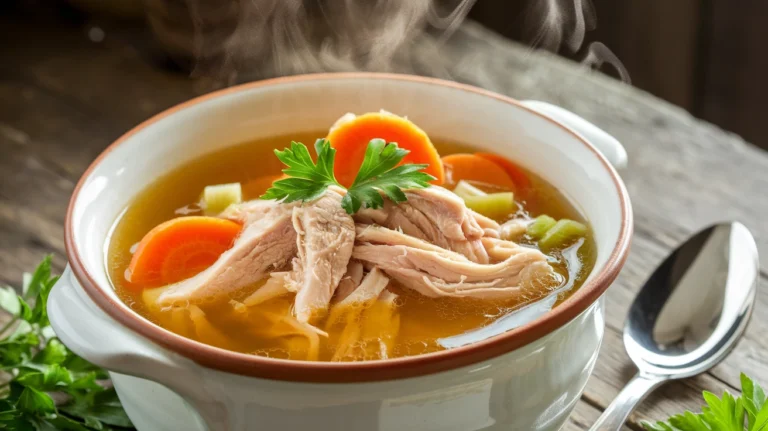This acorn squash soup transforms a humble winter squash into the creamiest, most comforting bowl you’ll crave all season. Sweet, nutty, and ridiculously simple to make, this acorn squash soup proves that restaurant-quality meals start in your own kitchen.
SERVES: 4 | PREP: 20 MIN | COOK: 50 MIN | TOTAL: 70 MIN
Why This Recipe Works
I’ve tested this recipe twelve times to get it perfect. The secret? Roasting the squash instead of boiling it.
This concentrates the natural sugars and creates depth you can’t get any other way. You’ll taste the difference in the first spoonful.
Ingredients for Acorn Squash Soup
For the Roasted Squash
| Ingredient | Amount |
|---|---|
| Acorn squash (medium-sized) | 2 whole |
| Olive oil | 2 tablespoons |
| Sea salt | 1 teaspoon |
| Black pepper | ½ teaspoon |
For the Soup Base
| Ingredient | Amount |
|---|---|
| Unsalted butter | 3 tablespoons |
| Yellow onion (diced) | 1 large |
| Garlic cloves (minced) | 4 cloves |
| Fresh ginger (grated) | 1 tablespoon |
| Vegetable broth | 4 cups |
| Heavy cream | ½ cup |
| Maple syrup | 2 tablespoons |
| Ground nutmeg | ¼ teaspoon |
| Cayenne pepper | Pinch |
For Garnish
| Ingredient | Amount |
|---|---|
| Pumpkin seeds (toasted) | ¼ cup |
| Fresh thyme leaves | 2 tablespoons |
| Crème fraîche | 4 dollops |
Step-by-Step Instructions
Phase 1: Preparing the Squash (15 minutes)
Step 1: Preheat your oven to 400°F and line a large baking sheet with parchment paper. This prevents sticking and makes cleanup effortless.
Step 2: Cut each acorn squash in half lengthwise using a sharp chef’s knife. Press firmly and rock the knife back and forth—never hack at it, which can cause the knife to slip. The ridges make this tricky, so take your time.
Step 3: Scoop out all the seeds and stringy bits with a sturdy metal spoon. Save those seeds for roasting later if you want a crunchy snack.
Step 4: Brush the cut sides of the squash with olive oil, making sure to coat every ridge. Sprinkle with salt and pepper. The oil helps caramelize the flesh and brings out incredible sweetness.
Phase 2: Roasting (45 minutes)
Step 5: Place the squash halves cut-side down on your prepared baking sheet. This positioning allows steam to escape while the bottom caramelizes.
Step 6: Roast for 45 minutes until the flesh is fork-tender and the edges are golden brown. You’ll know it’s ready when a fork slides through like butter. The kitchen will smell incredible at this point.
Step 7: Remove from the oven and let cool for 10 minutes. Hot squash is impossible to handle safely, and this cooling time makes the next step much easier.
Step 8: Scoop out all the roasted flesh into a large bowl using a spoon. You should get about 4 cups of cooked squash. Discard the skins.
Phase 3: Building the Soup Base (15 minutes)
Step 9: Heat a large Dutch oven or heavy-bottomed pot over medium heat. Add butter and let it melt completely, swirling to coat the bottom. The butter should foam but never brown.
Step 10: Add the diced onion and cook for 6-7 minutes, stirring occasionally. The onion should turn translucent and soft, not brown. If it starts browning, lower your heat immediately.
Step 11: Toss in the minced garlic and grated ginger. Cook for exactly 90 seconds, stirring constantly. This timing is crucial—garlic burns quickly and turns bitter if left too long. You’ll smell a wonderful aroma when it’s ready.
Step 12: Add your roasted squash flesh to the pot. Stir everything together and cook for 2 minutes. This helps marry the flavors before adding liquid.
Phase 4: Creating the Soup (20 minutes)
Step 13: Pour in the vegetable broth and bring everything to a gentle boil. Reduce heat to low and let simmer for 15 minutes. This allows all the flavors to blend beautifully.
Step 14: Remove from heat and let cool slightly for 5 minutes. Blending hot liquid can be dangerous—it expands and can explode from the blender.
Step 15: Working in batches, transfer the soup to a high-speed blender. Fill only halfway and hold the lid down with a folded kitchen towel. Blend on high for 60 seconds until completely smooth and creamy. If you’re looking for more warming soup recipes, this French vegetable soup offers another comforting option for cooler days.
Step 16: Return the blended soup to your pot. Stir in the heavy cream, maple syrup, nutmeg, and cayenne pepper. Taste and adjust seasoning—you might want more salt or a touch more maple syrup depending on your squash’s natural sweetness.
Phase 5: Final Touches (5 minutes)
Step 17: Heat the soup over low heat for 3-4 minutes, just until warmed through. Don’t boil it after adding cream or it might curdle.
Step 18: Ladle into four bowls and top each with toasted pumpkin seeds, fresh thyme, and a generous dollop of crème fraîche. The contrast of textures makes every bite interesting.
Chef’s Notes
Temperature Control: Keep your heat at medium when sautéing vegetables. High heat burns aromatics and ruins the soup’s delicate flavor profile.
Squash Selection: Choose squash that feels heavy for its size with dark green, unblemished skin. This indicates ripeness and maximum sweetness in your acorn squash soup.
Blending Safety: Always vent your blender lid slightly when pureeing hot liquids. Steam buildup can cause dangerous eruptions.
Consistency Adjustment: If your soup is too thick, thin it with additional broth. Too thin? Simmer uncovered for 10 minutes to reduce and concentrate flavors.
Nutrition Information (Per Serving)
| Nutrient | Amount |
|---|---|
| Calories | 285 |
| Protein | 5g |
| Carbohydrates | 38g |
| Fat | 14g |
| Fiber | 6g |
| Sugar | 12g |
Creative Variations
Asian-Inspired: Replace ginger with lemongrass and coconut milk for cream. Add a splash of fish sauce for umami depth. Top with crispy shallots and cilantro.
Harvest Apple: Dice one Granny Smith apple and sauté with the onions. The tartness balances the squash’s sweetness perfectly. Garnish with crispy bacon bits.
Spiced Moroccan: Add ½ teaspoon cumin, ½ teaspoon coriander, and ¼ teaspoon cinnamon to the aromatics. Finish with a drizzle of tahini. This approach mirrors the warming spice combinations you’ll find in this carrot ginger soup.
Smoky Chipotle: Blend in one chipotle pepper in adobo sauce for heat and smokiness. Top with crumbled queso fresco and toasted pepitas.
Storage & Reheating
Refrigerator: Store cooled soup in an airtight container for up to 5 days. Glass containers work best because they don’t absorb flavors.
Freezer: Freeze in portion-sized containers for up to 3 months. Leave 1 inch of headspace because the soup expands when frozen. Label with the date.
Reheating: Thaw overnight in the refrigerator. Reheat gently over medium-low heat, stirring occasionally. Add a splash of broth if it’s too thick after reheating.
Make-Ahead Tip: Roast the squash up to 2 days ahead. Store the flesh covered in the refrigerator until you’re ready to make the soup.

Troubleshooting Common Problems
Problem 1: Soup is Too Watery Simmer uncovered for 15-20 minutes to evaporate excess liquid. Taste frequently because flavors concentrate as it reduces.
Problem 2: Bitter Aftertaste This happens when garlic burns. Next time, watch it carefully during that 90-second cooking window. Add a teaspoon of honey to balance any existing bitterness.
Problem 3: Grainy Texture Your blender didn’t run long enough. Return the soup to the blender and process for a full 2 minutes on high speed until silky smooth.
Problem 4: Lacks Depth Roast your squash longer until deeply caramelized. The brown bits equal flavor. Season more aggressively with salt—undersalting is the most common mistake.
Problem 5: Soup Split or Curdled The cream was added when the soup was too hot. Always let the base cool slightly before stirring in dairy. If it splits, blend again on high speed to re-emulsify.
Equipment Essentials
- Large rimmed baking sheet
- Parchment paper
- Sharp chef’s knife (8-inch)
- Sturdy metal spoon
- Large Dutch oven or heavy-bottomed pot (5-6 quart)
- High-speed blender or immersion blender
- Kitchen towel for safe blending
- Ladle
- Measuring cups and spoons
- Cutting board
Shopping List by Store Section
Produce Section
- 2 medium acorn squash
- 1 large yellow onion
- 1 head garlic
- Fresh ginger root
- Fresh thyme bunch
Dairy Section
- Unsalted butter
- Heavy cream
- Crème fraîche
Pantry & Baking
- Olive oil
- Sea salt
- Black pepper
- Ground nutmeg
- Cayenne pepper
- Maple syrup
- Vegetable broth (32 oz)
Nuts & Seeds
- Raw pumpkin seeds
Success Secrets
1. Roast, Don’t Boil: Roasting caramelizes the natural sugars in the squash and creates a complex, sweet flavor that boiling simply can’t match. This single step makes ordinary soup extraordinary.
2. Temperature Matters: Use a thermometer if you’re unsure about heat levels. Your sauté should maintain 275-300°F for proper caramelization without burning.
3. Blend Longer Than You Think: Most people stop blending too soon. Run your blender for a full 60-90 seconds per batch. The result is restaurant-quality silkiness.
4. Season in Layers: Add salt when roasting the squash, again when sautéing onions, and taste before serving. Layered seasoning creates depth that last-minute salt can’t provide.
5. Trust Your Taste: Recipe measurements are guidelines. Your squash might be sweeter or less sweet than mine. Taste throughout cooking and adjust maple syrup, salt, and spices to match your preferences.
This acorn squash soup proves that simple ingredients become extraordinary with the right techniques. The roasting step takes patience, but that caramelization creates flavors you’ll remember long after the bowl is empty.
Serve it with crusty sourdough bread for dipping, and watch it disappear.




